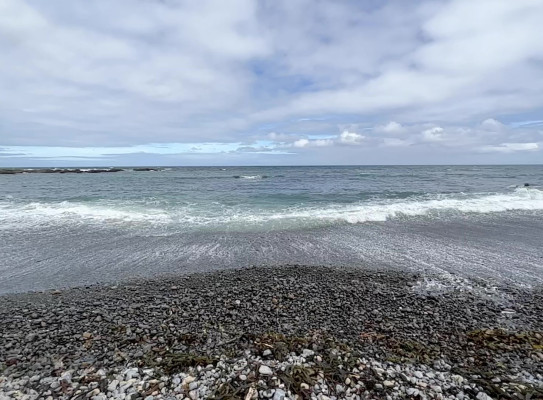
Silent tsunami risk in the Tasman Sea

This project seeks to understand more about underwater landslides to maximise New Zealand's resilience to the tsunami they may cause.
Overview
GNS Science leads this Endeavour-funded research project, which is a collaboration with NIWA, the University of Auckland, the University of Newcastle, Australia and iwi partners Ngāti Tama and Ngāti Mutunga.
The project aims to
- carry out early-stage research examining the link between underwater landslides and tsunami
- understand the tsunamigenic potential of New Zealand’s largest-known underwater landslides
- test new ways to integrate underwater landslide sources into our national tsunami hazard assessments
To achieve these objectives, we will
- study evidence of giant, prehistoric landslides off the coast of Aotearoa New Zealand
- collect new seafloor maps, subsurface geophysical images and seafloor sediment samples to help describe these landslides and the conditions that led to their occurrence
- run numerical simulations of these landslides to study their potential to generate tsunami
The project
Landslides – the #2 cause of tsunami
Underwater landslides are the second-most common cause of tsunami after earthquakes. Scientists estimate that around 10% of tsunami are caused by underwater landslides. During a landslide, a large area of the seafloor is suddenly displaced. This can cause a "drag down" effect, creating a trough in the ocean’s surface. Water rushes in to fill the trough, producing a swell, followed by multiple oscillations that propagated outward – tsunami waves.
Jam Roll Bay | Virtual Field Trip – “Fossilised” underwater landslides explained (using cake) transcript
So we're off to a very special place called Takawa park. It's a historic reserve on a pa site but it's also affectionately known as Jam Roll Bay.
All right so we've made it down onto the beach. Welcome to Jam Roll Bay in northern Taranaki.
We're here to investigate a really interesting rock formation with a bit of help from cake.
So here I am in front of the jam roll rock, and this is a real jam roll if you take a look the two of them have some similarities. The pale layers, we can imagine they're a bit like the sponge cake. They've curved around quite nicely, and kept their shape. The darker material is thin in some places and thick in others, and looks like it's been easily squished and squeezed into the gaps a bit like the jam.
An understanding that these layers of rock have behaved like layers of sponge cake and jam, actually helps us understand how it forms.
The rocks here at Jam Roll Bay are all sedimentary rocks, so these are the type of rocks that started off as soft, waterlogged layers at the bottom of the sea.
So if that explains how the rocks could be bendy, the next question is well what rolled them up into this incredible rock formation. If we look all around us here at Jam Roll Bay the rocks show all kinds of mind-bending squiggles and folds and patterns. And this indicates to us that this whole area formed as part of a giant submarine landslide millions of years ago.
Submarine landslides happen underneath the sea when layers of soft and waterlogged sediments are destabilized by some sort of trigger like an earthquake. They start slipping and sliding into the deepest parts of the ocean and can get all wrapped up and squished and deformed into these sorts of amazing rock formations on their way.
Jam Roll Bay | Virtual Field Trip
“Fossilised” underwater landslides explained (using cake)
Aotearoa New Zealand’s vulnerability
Aotearoa New Zealand is vulnerable to rare but destructive tsunami. While earthquakes are the most likely cause of these tsunami, New Zealand is also surrounded by numerous examples of underwater slips.
A series of six events have been discovered in the eastern Tasman Sea, near the Taranaki/Waikato coastline. These landslides have been buried beneath younger layers of sediment and have been unexplored from a hazard perspective.
Assessing silent tsunami risk
This project will investigate these six underwater landslides, the largest ever found in New Zealand waters. The research conducted by this project will answer these questions:
- What caused these events?
- How frequent are they?
- Is another one likely to happen in the future?
- And, if so, how can we best prepare?
To answer these questions, we will use a mixture of existing subsurface geological information and new data, including seafloor maps and sediment cores, that we will collect using New Zealand’s research vessel Tangaroa.
The data we collect will inform the likelihood of a future landslide-tsunami recurrence and strategies for hazard risk mitigation. This evidence will be supplemented by pūrākau (historical stories) and mātauranga (traditional scientific knowledge) relating to past tsunami events in the impact regions.
The results will provide a clearer picture of the threat posed by landslide-triggered tsunami in the regions bordering the Tasman Sea, including eastern Australia, and will also improve our understanding of this hazard across the rest of New Zealand, contributing to enhanced hazard assessment and improved resilience.

Research programme details
Collaborators: NIWA, University of Auckland, University of Newcastle, Ngāti Tama, Ngāti Mutunga
Duration
2021–2023
Funding platform
Endeavour Fund 2021 “Smart Ideas”
Status
Current/future
Programme leader
Suzanne Bull, GNS Science
Funder
MBIE